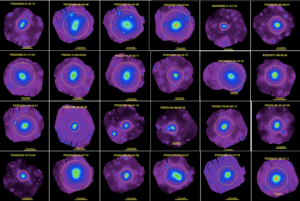Clusters of galaxies provide valuable information on cosmology, on the physics driving structure and galaxy formation, on the nature of dark matter and dark energy. Their matter content reflects that of the Universe (85% dark matter, 12% X-ray emitting gas and 3% galaxies). They are the nodes of the Cosmic Web, constantly growing through the accretion of matter along filaments and via occasional mergers. Clusters are thus excellent laboratories for probing the physics of the gravitational collapse of dark matter and baryons, and for studying the non-gravitational physics that affects their baryonic component. The hot (with a temperature of millions of degrees) tenuous plasma -the intracluster medium (ICM)- accounts for the vast majority (85%) of their baryonic content, and is observable in two main complementary ways, in X-ray and through the Sunyaev- Zeldovich (SZ) effect, due to the inverse Compton scattering of the CMB photons on the ICM electrons.
Our group at OAS (S. Ettori, M. Roncarelli, M. Sereno, M. Meneghetti) works on the formation and evolution of Clusters of Galaxies, focusing its activities on:
-
the physical properties of the Intra-Cluster Medium from the core to the outskirts where mass accretion is occurring;
-
the use of Galaxy Clusters as cosmological probes through the measurement of their baryonic and dark matter content.
We also work on hydrodynamical (cosmological) simulations to study the properties of dark matter and ICM under controlled conditions.

Current main projects are:
- XMM Heritage Cluster Project (CHEX-MATE): 3 Msec with XMM-Newton obtained in the 2017 call (PI: M. Arnaud & S. Ettori) to analyze the ultimate sample of 118 Planck SZ-selected objects, comprising an unbiased census of both the population of clusters at the most recent time (z < 0.2) and the most massive objects to have formed thus far in the history of the Universe, to study the culmination of cosmic structure formation;
- X-COP: an XMM-Newton Very Large program dedicated to the study of the X-ray emission in the outskirts of twelve massive local galaxy clusters;
- CLUster Multi-Probes in Three Dimensions (CLUMP-3D): to infer unbiased measurements of mass distribution, intrinsic shape and equilibrium status of galaxy clusters by exploiting rich multi-bands data-sets;
- CLASH-VLT: a panoramic spectroscopic survey with VIMOS/VLT of 12 massive clusters at redshifts ~0.2-0.6, drawn from the sample of the HST Multi-Treasury program CLASH;
- XXL: an XMM-Newton Very Large program to observe two extragalactic regions of 25 deg2, and study the distribution of galaxy clusters and Active Galactic Nuclei in these contiguous regions;
- collaboration in exploiting numerical simulations to explore the physics of the ICM and its observational properties (e.g. with F. Brighenti, C. Nipoti, F. Vazza -DIFA Univ Bologna; K. Dolag, Munich Univ);
- specific support to build the scientific case for the next-generation missions, like Euclid and Athena, that will use galaxy clusters as one of the major proxies to explore the mass and energetic components of the universe.
